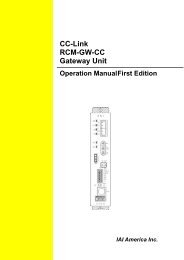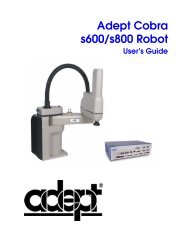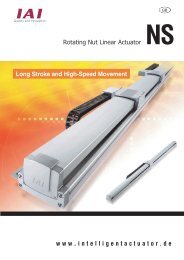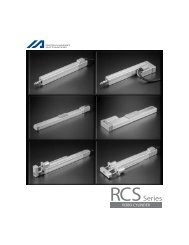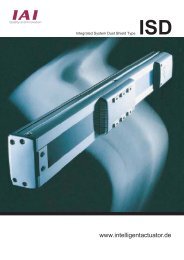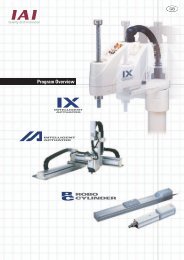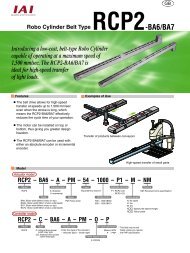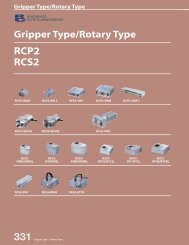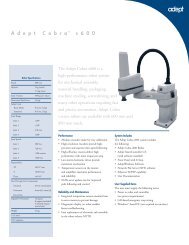Controller
Controller
Controller
Create successful ePaper yourself
Turn your PDF publications into a flip-book with our unique Google optimized e-Paper software.
Explanation of I/O Signal Functions<br />
For enquiries,<br />
call 0800-888-0088 (toll-free).<br />
ACON <strong>Controller</strong><br />
<strong>Controller</strong> -<br />
Integrated Type<br />
The table below explains the functions assigned to the respective I/O signals of the controller.<br />
Since the signals that can be used vary depending on the controller type and settings, check the signal table for each<br />
controller to confirm the available functions.<br />
n <strong>Controller</strong> Functions by Type<br />
Slider<br />
Type<br />
Rod<br />
Type<br />
Category<br />
Input<br />
Abbreviation<br />
CSTR<br />
Signal name<br />
PTP strobe signal (start signal)<br />
Input this signal to cause the actuator to start moving to the position set by the<br />
command position number signal.<br />
PC1~PC256 Command position number signal This signal is used to input a target position number (binary input).<br />
BKRL Brake forced-release signal This signal forcibly releases the brake.<br />
RMOD<br />
Running mode switching signal<br />
* STP Pause signal<br />
RES<br />
MODE<br />
Reset signal<br />
Teaching mode signal<br />
Function description<br />
This signal can switch the running mode when the MODE switch on the controller is<br />
set to AUTO (AUTO when this signal is OFF, or MANU when the signal is ON).<br />
Turning this signal OFF causes the moving actuator to decelerate to a stop. The actuator<br />
will resume the remaining movement if the signal is turned OFF during the pause.<br />
Turning this signal ON resets the alarms that are present. If this signal is turned ON<br />
while the actuator is paused (*STP is OFF), the remaining movement can be cancelled.<br />
SON Servo ON signal The servo remains on while this signal is ON, or off while the signal is OFF.<br />
HOME Home return signal Turning this signal ON performs home-return operation.<br />
JISL<br />
Jog/inching switching signal<br />
Turning this signal ON switches the controller to the teaching mode (provided that<br />
CSTR, JOG+ and JOG- are all OFF and the actuator is not moving).<br />
The actuator can be jogged with JOG+ and JOG- while this signal is OFF. The<br />
actuator performs inching operation with JOG+ and JOG- while this signal is ON.<br />
Arm / Flat<br />
Type<br />
Gripper /<br />
Rotary Type<br />
Cleanroom<br />
Type<br />
Splash<br />
Proof Type<br />
<strong>Controller</strong><br />
JOG+ JOG– ------ ----<br />
PWRT<br />
ST0~ST6<br />
TL<br />
Start position command<br />
Torque limit selection signal<br />
Turning this signal ON in the solenoid valve mode causes the actuator to move to the<br />
specified position. (Start signal is not required.)<br />
While this signal is ON, torque is limited by the value set by a parameter. The TLR<br />
signal turns ON if torque has reached the specified value.<br />
DCLR Deviation counter clear signal The position deviation counter is continuously cleared while this signal is ON.<br />
PEND/INP<br />
PM1~PM256<br />
Teaching signal<br />
Position complete signal<br />
Completed position number signal<br />
In the teaching mode, specify a desired position number and then turn this signal ON<br />
for at least 20 ms to write the current position under the specified position number.<br />
This signal turns ON when the actuator has entered the positioning band after<br />
movement. If the actuator has exceeded the positioning band, PEND does not turn<br />
OFF, but INP does. PEND and INP can be swapped using a parameter.<br />
This signal is used to output the position number achieved at completion of<br />
positioning (binary output).<br />
HEND Home return complete signal This signal turns ON upon completion of home return.<br />
ZONE1<br />
PZONE<br />
Zone signal<br />
Position zone signal<br />
This signal turns ON when the current actuator position has entered the range<br />
specified by parameters.<br />
This signal turns ON when the current actuator position has entered the range<br />
specified by position data during position movement. PZONE can be used together<br />
with ZONE1, but PZONE is valid only during movement to a specified position.<br />
<strong>Controller</strong><br />
Models<br />
Gateway<br />
unit<br />
PS-24<br />
ERC2<br />
Output<br />
RMDS Running mode status signal This signal is used to output the running mode status.<br />
* ALM <strong>Controller</strong> alarm status signal<br />
MOVE<br />
SV<br />
Servo ON status signal<br />
* EMGS Emergency stop status signal<br />
MODES<br />
WEND<br />
PE0~PE6<br />
TLR<br />
LSO~LS2<br />
TRQS<br />
Moving signal<br />
Mode status signal<br />
Write complete signal<br />
Current position number signal<br />
Torque limiting signal<br />
Limit switch output signal<br />
---<br />
This signal remains ON while the controller is normal, and turns OFF if an alarm has<br />
generated.<br />
This signal remains ON while the actuator is moving (including the periods during<br />
home return and push-motion operation).<br />
This signal remains ON while the servo is on.<br />
This signal remains ON while the controller is not in the emergency stop mode, and<br />
turns OFF once an emergency stop has been actuated.<br />
This signal turns ON when the controller has switched to the teaching mode via<br />
MODE signal input. It turns OFF upon returning to the normal mode.<br />
This signal remains OFF after the controller has switched to the teaching mode. It<br />
turns ON upon completion of data write using the PWRT signal. If the PWRT signal is<br />
turned OFF, this signal also turns OFF.<br />
This signal turns ON after the controller has completed moving to the target position<br />
in the solenoid valve mode.<br />
This signal turns ON once the motor torque has reached the specified value in a<br />
condition where torque is being limited by the TL signal.<br />
Each signal turns ON when the current actuator position has entered the positioning band<br />
before or after the target position. If the actuator has already completed home return, these<br />
signals are output even before a movement command is issued or while the servo is OFF.<br />
--------<br />
ACON 318<br />
PCON ACON SCON PSEL ASEL SSEL XSEL





